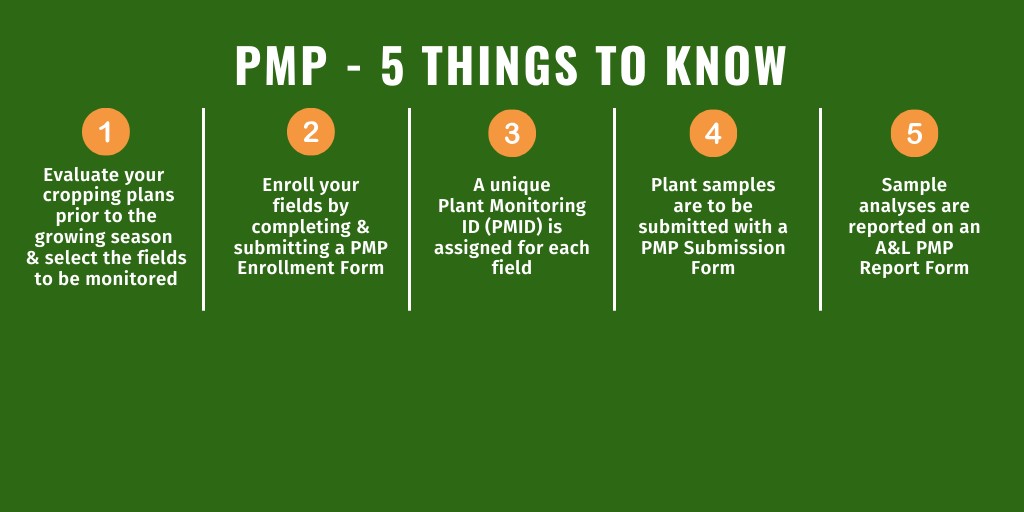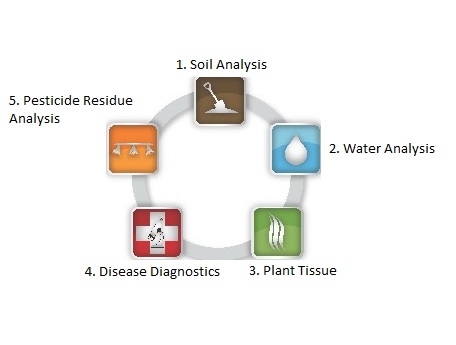- Home
-
A&L Services
Loading...Loading data...Loading...
- News
- Payment
- Reference & Tools
- About
- Contact
- Workshops
- Quick links
Importance of Plant Analysis
Plant analysis is an important nutrient management tool. Monitoring of plant nutrient levels at critical crop growth stages through the growing season can help identify potential and existing nutritional problems that can affect crop quality and yield.
In addition to our standard tissue testing, we are pleased to offer a special Plant Monitoring Program (PMP). The PMP is a nutrient management tool used to track nutrient levels of a crop at critical growth stages. By intermittently analyzing a crop and examining nutrient levels and trends, existing and potential nutritional problems can be identified before physical symptoms of deficiency are present.
Unfortunately, once visual symptoms of nutrient deficiencies are present crop yield can already be affected.
In certain instances, a crop that has been set up to produce a high yield potential may run out of nutrient supply simply because of the demand it places on the soil and the soils ability to supply certain nutrients before it becomes yield limiting. In some years a soil may not have the potential to finish those huge crops. Soil physical and fertility status as well as weather conditions the crop has experienced up to the time of sampling may also influence the nutrient levels in the plant. A plant's nutrient demand changes quickly in season as it goes from one stage of growth to another.
It is important to note that the PMP package contains all the analysis performed in the PT1 or PT2. The PMP provides a valuable tool for growers to monitor and track the nutrient levels illuminated by these analyses, and in turn, tailor nutrients appropriately during the growth stages of the crop.
There is no cost to enroll samples in the Plant Monitoring Program (PMP) and you only pay for each plant analysis. Growers are encouraged to contact us to enroll your samples or to find out more information on this service.

When and How Often Should I Sample?
It is best to start tissue testing programs early before problems occur. Before taking tissue samples, ensure that the timing and location of samples makes sense with the end goal you are trying to achieve. Each individual grower's sampling dates and frequencies may vary due to different geographies, crops and end goals of the program. For example, some growers may be aiming to compare different fertility programs or drive a crop to its highest achievable yield and quality by top dressing or adding foliar nutrition.
By monitoring nutrient concentrations on a regular basis throughout the growing season multiple opportunities to evaluate the plant's nutritional condition to predict nutrient deficiencies that rob our crops of yield and quality are provided. It is also an excellent tool to monitor and fine-tune crop nutrient supply during the growing season.
It is important to note that when using a monitoring program your largest crop will run out of nutrients the quickest. A poor or low tissue test does not always mean a poor crop; it usually means there is a lot of demand on nutrient supply because the crop is using the nutrients. In other words, your best crop may have the poorest tissue test. Make sure you identify this & respond with correctives before it is too late.
What Should I Do After I Receive My Result Back?
If a nutrient deficiency is identified, for a nutrient correction to be effective, it must be dealt with as quickly as possible. If the nutrient deficiency reaches critical thresholds (often when visual symptoms are exhibited) it is too late to make a correction and the end yield of the crop has already been reduced.


